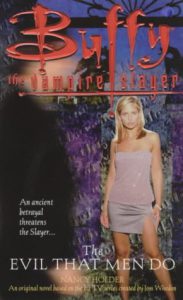By a quirk of timing, “Buffy the Vampire Slayer” became linked with the 1999 Columbine school shootings. The WB pushed the airings of “Earshot” (3.18) and “Graduation Day, Part 2” (3.22) into the summer, citing the sensitive subject matter. In reality, neither episode explores school shootings, let alone takes a political stance on them. In “Earshot,” it’s a fake-out: Jonathan aims to kill himself with a gun, and the lunch lady aims to poison the students. In “Graduation Day, Part 2,” the “school violence” is self-defense against an evil demon, and the students don’t use guns.
So, despite the connection forged by the WB’s scheduling decisions, “Buffy” itself didn’t dig into the issue. Perhaps inspired by this open opportunity, Nancy Holder starts her first solo “Buffy” novel, “The Evil That Men Do” (July 2000), with Sunnydale High student Brian Dellasandra shooting up the grounds from a window perch. Xander saves the life of a fellow student — a jock who had harassed him — by putting a tourniquet on his wound, and it’s a nice illustration of how when things go to hell, petty differences are forgotten.
By the title, one might think Holder is digging into evil done by humans (as opposed to supernatural creatures), but that’s not the case: The school shooting is just an opening salvo in a book that goes in a different direction. And Brian is under the influence of a magic potion anyway, so it’s technically a case of supernatural evil.
The title, as Holder reveals in the closing pages, refers to a line from Shakespeare’s “Julius Caesar” about how a person’s goodness dies with them, but their evil lives on through others – and that does indeed fit with the book’s theme. The villains are ancient vampire couple Julian and Helen, who date back to the 1st century Roman reign of Caligula (whom Holder intriguingly posits knew about vampires and magic) but have a lot in common with the more recent Darla-Angel-Drusilla-Spike clan. They were decent people in life, but of course became evil in “death” as vampires.
“The Evil That Men Do” is overloaded with big events that make the idea of fitting it onto the Season 3 timeline insane, although I would place it somewhere after “Earshot,” as that brief school-shooting fear feels like a precursor to the actual horror of this book more so than a follow-up. And I’d put it before “The Prom” (3.20), as the way Buffy helps Brian’s brother, Mark, makes this another example of why she is worthy of the Class Protector award.
That also puts this story in the time when Faith is working for the Mayor, and that makes sense, because the action takes place over at least eight days. (When Oz is kidnapped by Julian and Helen’s henchmen, he tells them it will be eight days until the next full moon. When he wolfs out, they pit Oz against Buffy in the closing fight.) Through most of those eight days, the town is in chaos since everyone is under the influence of the magic potion which had been put into the water supply – imagine “Band Candy” (3.6) times a hundred. Good Slayer Faith wouldn’t sit that out, but Bad Slayer Faith would have.

That having been said, it’s still crazy that the big emotions and epic happenings of “The Evil That Men Do” could’ve happened during this time period. I often admire the way Holder (and Golden, and their collaborative works) aims big, but this yarn goes too big.
The Scoobies insult each other under the potion’s influence, making this a very bleak read – even more so than “Blooded,” when Willow is peeved at Buffy. Buffy thinks Angel is dead for a long stretch. Xander has an ugly feud with a mean teacher (who, on page 95, references Xander’s older brother, a character previously mentioned in “Child of the Hunt” but never on the TV show). Oz and Cordelia – in a sneak preview of Warrior Cordy on “Angel” – are trained over the course of a week to fight Buffy in the closing battle, which plays out like “The Ring” (“Angel” 1.16). Giles’ house is utterly destroyed, as is the Alibi Room and a gas station.
I’m a little more forgiving of epic backstories and villainous schemes – that’s where “Buffy” authors really have free reign to invent stuff – but even here Holder shows no restraint. Helen has killed so many Slayers (20!) that Spike would be abashed for bragging about his two kills – and she keeps a collection of their skulls. Helen still pines for Angel, even though she’s a footnote in his memories. The demon that Helen and Julian aim to bring into the world is like the Acathla statue (from the end of Season 2) except it can talk and make the ground shake.
Ultimately, the baddies are dispatched in an underground throwdown so massive that a fissure forms in the Earth; it’s reminiscent of “The Dust Waltz” comic book, also about a super-powerful ancient vampire. The scope of these fights is actually bigger than when the Hellmouth opens in “Prophecy Girl” (1.12) and “The Zeppo” (3.13).
“The Evil That Men Do” has a lot of good ideas, but doesn’t spend enough time on any one idea – thus undercutting all of them. If Holder had contained the action to Sunnydale High, and emphasized the notion of a school building as an unsafe place, it could’ve made for a powerful piece of reading, but she for some reason wants to cram in all this other stuff.
Holder doesn’t even show us the scene where Willow takes a bullet in the school shooting; we just cut to her in the hospital. There’s no way the TV writing team would skim over something like that. A gun would of course play a major role in Willow’s life in Season 6, when Tara is killed by Warren’s stray bullet, so this is the latest example of the spinoff stories hinting at a future story on the TV show. Most fans would say that’s the only “real” continuity – and I don’t entirely blame them.
Click here for an index of all of John’s “Buffy” and “Angel” reviews.

